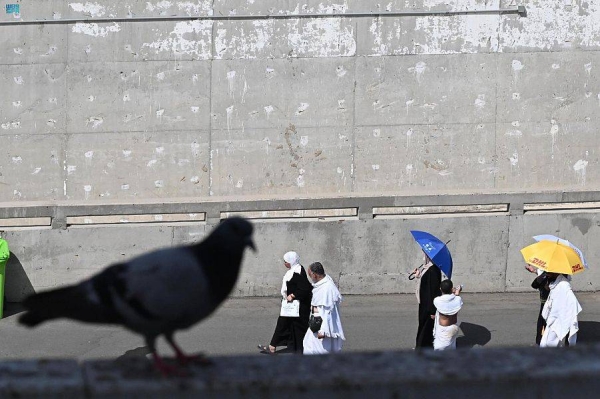
MINA — Pilgrims performed four main rituals of Hajj on Friday, (Dhul Hijjah 10), which is also known as Yaum Al-Nahr or the Day of Sacrifice when most Muslims other than pilgrims all over the world started celebrating Eid Al-Adha festival.
After reaching Mina from Muzdalifah in the morning, the pilgrims performed stoning at Jamarat Al-Aqba (biggest pillar symbolizing Satan), sacrificed animals, and they had a partial exit (first Tahallul) from the state of ihram by shaving or cutting their hair for men while women trim the length of a finger-tip from one strand of hair. Pilgrims then changed back into normal clothing from ihram.
Pilgrims, then, proceeded to Makkah to perform Tawaf Al-Ifada and sai’ (ritual of running between Safa and Marwah), two other pillars of Haj. Those pilgrims who performed sai along with Tawaful Qudum (tawaf of arrival) need not perform sai again.
With this, they would exit completely from the state of ihram. In the remaining three days of Hajj, which are known as Ayyamu Tashreeq or Tashreeq Days, the only ritual to be performed is stoning at each of the three Jamarat (Jamarat Al-Sughra, Jamarat Al-Wusta and Jamarat Al-Aqba) seven times after staying three nights in Mina. Pilgrims bought coupons of Adahi for the sacrificial animal from the Islamic Development Bank (IsDB), which supervises the Kingdom’s Sacrificial Meat Utilization Program.
Meanwhile, the General Department of Analysis and Forecasts at the General Authority of Meteorology and Environmental Protection warned that Makkah and the holy sites of Mina, Arafat and Muzdalifah will experience moderate to heavy rains on Friday. The rain, accompanied by sand storm, would result into low visibility, hail and torrential flow. The authority predicted that the inclement weather would continue until 9 p.m.
Pilgrims had a busy day on Friday as they completed four main rituals of Hajj. After proceeding from Muzdalifah where they spent overnight after their Wuquf (standing) at Arafat, the most important ritual of Haj the previous day, they reached Mina and performed first ritual of stoning. Pilgrims used seven pebbles for the stoning ritual at Jamarat Al-Aqba.
Pilgrims were provided with sterilized pebbles in wrapped bags. They were allowed to move to Jamarat on their scheduled time so that the number of pilgrims who throw stones at a time does not exceed 50 pilgrims for each floor of the Jamarat complex and they had to maintain a distance of 1.5 to two meters between two of them while performing the ritual of stoning.
The Commander of the Jamarat Complex Brig. Gen. Abdul-Rahman Al-Qahtani said that pilgrims performed today’s stoning ritual in a smooth and orderly manner and that is strictly in line with the COVID-19 preventive protocols.
“During this year’s exceptional pilgrimage, pilgrims were allowed to perform the ritual of stoning only from the ground floor of the Jamarat Complex on Friday. They will be allowed to perform the ritual from the first and the third floors over the coming days of the pilgrimage,” he said adding that the foolproof mechanism for the stoning ritual has been worked out in coordination and cooperation with all the security, health and service agencies, with a focus on social distancing and face masks with the entry and exit of the pilgrims through different gates.
On his part, Maj. Gen. Mohammed Al-Bassami, assistant director-general of traffic and commander of the Hajj Security Forces for traffic affairs, said that the movement of pilgrims from Muzdalifah after the dawn (fajr) prayer was very smooth and orderly, and they arrived at the Jamarat complex to perform the stoning ritual on their scheduled time. “The security plans that were put in place for this year’s Hajj season have achieved their goals and we are still continuing to implement the plans for the rest of the days,” he added.
Several pilgrims expressed their excitement and delight over the extraordinary facilities and services arranged by the Saudi authorities. The use of smart bracelets, titled “Tatman” was the first-ever experience for the Hajj pilgrims during this year’s unprecedented pilgrimage. This bracelet was instrumental in guiding and regulating the movement of pilgrims and enabling them to have uninterrupted communications with their guides and Hajj officials.
The bracelet is connected to the pilgrim’s phone by using Bluetooth technology and can use for a maximum of 30 days without the need to recharge and it is characterized by lightweight with a comfortable wrist strap. The characteristics of the bracelet also include direct alerts if the connection is lost or tampered with or there is an attempt to get rid of it. It also contributes to maintaining the home quarantine of pilgrims after the completion of the Hajj rituals.
The Ministry of Hajj and Umrah provided housing for pilgrims in the residential towers in Mina after taking precautions and preventive measures. Pre-prepared meals are being provided to pilgrims. The ministry also supplied all the pilgrims with masks, umbrellas, prayer rugs, and other supplies needed for their compliance with the coronavirus protocols.








